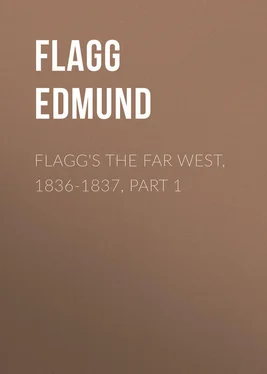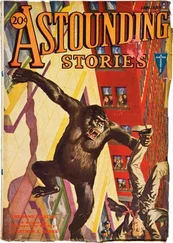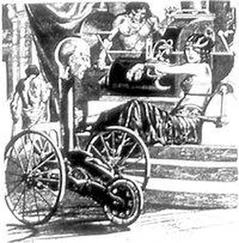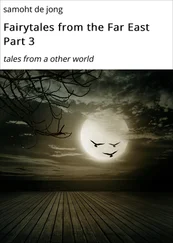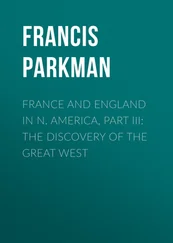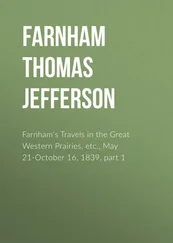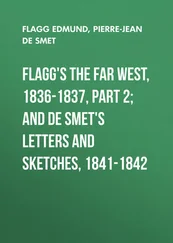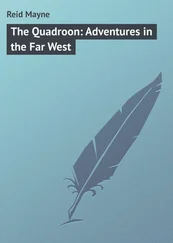Edmund Flagg - Flagg's The Far West, 1836-1837, part 1
Здесь есть возможность читать онлайн «Edmund Flagg - Flagg's The Far West, 1836-1837, part 1» — ознакомительный отрывок электронной книги совершенно бесплатно, а после прочтения отрывка купить полную версию. В некоторых случаях можно слушать аудио, скачать через торрент в формате fb2 и присутствует краткое содержание. Издательство: Иностранный паблик, Жанр: foreign_antique, foreign_prose, Путешествия и география, на английском языке. Описание произведения, (предисловие) а так же отзывы посетителей доступны на портале библиотеки ЛибКат.
- Название:Flagg's The Far West, 1836-1837, part 1
- Автор:
- Издательство:Иностранный паблик
- Жанр:
- Год:неизвестен
- ISBN:нет данных
- Рейтинг книги:4 / 5. Голосов: 1
-
Избранное:Добавить в избранное
- Отзывы:
-
Ваша оценка:
- 80
- 1
- 2
- 3
- 4
- 5
Flagg's The Far West, 1836-1837, part 1: краткое содержание, описание и аннотация
Предлагаем к чтению аннотацию, описание, краткое содержание или предисловие (зависит от того, что написал сам автор книги «Flagg's The Far West, 1836-1837, part 1»). Если вы не нашли необходимую информацию о книге — напишите в комментариях, мы постараемся отыскать её.
Flagg's The Far West, 1836-1837, part 1 — читать онлайн ознакомительный отрывок
Ниже представлен текст книги, разбитый по страницам. Система сохранения места последней прочитанной страницы, позволяет с удобством читать онлайн бесплатно книгу «Flagg's The Far West, 1836-1837, part 1», без необходимости каждый раз заново искать на чём Вы остановились. Поставьте закладку, и сможете в любой момент перейти на страницу, на которой закончили чтение.
Интервал:
Закладка:
The modern reader cannot but wish that Flagg had devoted less space to his youthful philosophizing, but the atmosphere is at least wholesome. Unlike Harris, whose criticism of Western society was keen and acrid, Flagg was a man of broad sympathies, possessing an insight into human nature remarkable for so youthful a writer – for he was but twenty years of age at the time of his travels, and twenty-two when the book was published. Although mildly reproving the old French settlers for their lack of enterprise, he fully appreciates their domestic virtues, and gives a faithful picture of these pleasure-loving, contented, unprogressive people. His description of the once thriving villages of Kaskaskia, Prairie du Rocher, and Cahokia, are valuable historically, as showing the decay settling upon the French civilization after a few years of American occupation. Our author's interview with the Mormon convert, his conversations with early French and American settlers, his accounts of political meetings, his anecdotes illustrating Western curiosity, and particularly his carefully-recounted local traditions, throw much light on the beliefs, manners, and customs of the Western people of his time. The Far West is thus not only a graphic and often forceful description of the interesting region through which the author travelled, but a sympathetic synopsis of its local annals, affording much varied information not otherwise obtainable. The present reprint, with annotations that seek to correct its errors, will, we think, prove welcome in our series.
In the Letters and Sketches of Father de Smet, we reprint another Western classic, related to the volumes of Flagg by their common terminus of travel at St. Louis.
No more interesting or picturesque episode has occurred in the history of Christian missions in the New World, than the famous visit made in the autumn of 1831 to General William Clark at St. Louis by the Flathead chiefs seeking religious instruction for their people. Vigorously exploited in the denominational papers of the East, this delegation aroused a sentiment that led to the founding of Protestant missions in Oregon and western Idaho, and incidentally to the solution of the Oregon question. But in point of fact, the Flathead deputation was sent to secure a Catholic missionary; and not merely one but four such embassies embarked for St. Louis before the great desideratum, a "black robe" priest, could be secured for ministration to this far-distant tribe. Employed in the Columbian fur-trade were a number of Christian Iroquois from Canada, who had been carefully trained at St. Regis and Caughnawaga in all the observances of the Roman Catholic church. Upon the Pacific waterways and in the fastnesses of the Rockies, these Iroquois taught their fellow Indians the ordinances of the church and the commands of the white man's Great Spirit. John Wyeth (see our volume xxi) testifies to the honesty and humanity of the Flathead tribe: "they do not lie, steal, nor rob any one, unless when driven too near to starvation." He also testifies that they "appear to keep the Sabbath;" and that their word is "as good as the Bible." These were the neophytes who craved instruction, and to whom was assigned that remarkable Jesuit missionary, Father Jean Pierre de Smet.
Born in Belgium in 1801, young De Smet was educated in a religious school at Malines. When twenty years of age he responded to an appeal to cross the Atlantic and carry the gospel to the red men of the Western continent. Arrived in Philadelphia (1821), the young Belgian was astonished to see a well-built town, travelled roads, cultivated farms, and other appurtenances of civilization; he had expected only a wilderness and savages. Two years were spent in the Jesuit novitiate in Maryland, before the zealous youth saw any traces of frontier life. Then the youthful novice was removed to Florissant, Missouri, not far from St. Louis, where the making of a log-cabin and the breaking of fresh soil furnished a mild foretaste of his future career. Still more years elapsed before the cherished project of missionary labor could be realized. In 1829 St. Louis University was founded, and herein the young priest, who had been ordained in 1827, was employed upon the instructional force. Later years (1833-37) were spent in Europe, while recruiting his health and securing supplies for the infant university. It was not until 1838 that the first missionary enterprise was undertaken by Father de Smet, when a chapel for the Potawatomi was built on the site of the modern Council Bluffs. There, in 1839, the fourth Flathead deputation rested after the long journey from their Rocky Mountain home; and at the earnest solicitation of the young missioner, he was in the spring of 1840, detailed by his superior to ascertain and report upon the prospects of a mission to the mountain Indians.
Of the two tribesmen who had come down to St. Louis, Pierre the Left-handed (Gaucher) was sent back to his people with news of the success of the embassy, while his colleague Ignace was detained to serve as guide to the adventurous Jesuit who in April, 1840, set forth for the Flathead country with the annual fur-trade caravan. The route traversed was the well-known Oregon Trail as far as the Green River rendezvous; there the father was rejoiced to meet a deputation of ten Flatheads, sent to escort him to their habitat, and at Prairie de la Messe was celebrated for them the first mass in the Western mountains. The trail led them on through Jackson's and Pierre's Holes; and in the latter valley the waiting tribesmen to the number of sixteen hundred had collected, and received the "black robe" as a messenger from Heaven. Chants and prayers were heard on every side; "in a fortnight," reports the delighted missionary, "all knew their prayers." After two months spent among his "dear Flatheads," wandering with them across the divide, and encamping for some time at the Three Forks of the Missouri – where nearly forty years before Lewis and Clark first encountered the Western Indians – De Smet took leave of his neophytes. Protected by a strong guard through the hostile Blackfeet country, he arrived at last at the fur-trade post of Fort Union at the junction of the Missouri and the Yellowstone. Descending thence to St. Louis he arrived there on the last day of December, 1840.
The remainder of the winter was occupied in preparations for a new journey, and in securing men and supplies for the equipment of the far-away mission begun under such favorable auspices. Once more the father departed from Westport – this time in May, 1841. The little company consisted, besides himself, of two other priests and three lay brothers, all of the latter being skilled mechanics. Among the members of the caravan were a number of California pioneers, one of whom has thus related his impressions of the young missionary: "He was genial, of fine presence, and one of the saintliest men I have ever known, and I cannot wonder that the Indians were made to believe him divinely protected. He was a man of great kindness and great affability under all circumstances; nothing seemed to disturb his temper." 2 2 John Bidwell, "First Emigrant Train to California," in Century Magazine , new series, xix, pp. 113, 114.
Father de Smet's letters describe in detail the scenery and incidents of the route from the eastern border of Kansas to Fort Hall, in Idaho, where the British factor received the travellers with abounding hospitality. Here some of the Flatheads were in waiting to convey the missionaries to the tribe, the chiefs of which met them in Beaver Head Valley, Montana, and testified their welcome with dignified simplicity. Passing over to the waters of the Columbia, they founded the mission of St. Mary upon the first Sunday in October, in the beautiful Bitter Root valley at the site of the later Fort Owen. Thence Father de Smet made a rapid journey in search of provisions to Fort Colville, on the upper Columbia, but was again at his mission stockade before the close of the year. In April a longer journey was projected, as far as Fort Vancouver, on the lower Columbia, where Dr. McLoughlin, the British factor, received the good priest with that cordial greeting for which he was already famous. During this journey the father narrowly escaped drowning in the turbulent rapids of the Columbia, where five of his boatmen perished. Returned to St. Mary's, the prospects for a harvest of souls both among the Flatheads and the neighboring tribes appeared so promising that the missionary determined to seek re-enforcement and further aid in Europe. Thereupon he left his companions in charge of the "new Paraguay" of his hopes, and once more undertook the long and adventurous journey to the settlements, this time by way of the Yellowstone and Missouri rivers, arriving at St. Louis the last of October, 1842. At this point the journeys detailed in the volume here reprinted come to an end. The later career of Father de Smet and his subsequent journeyings will be detailed in the preface to volumes xxviii and xxix, in the latter of which will appear his Oregon Missions .
Читать дальшеИнтервал:
Закладка:
Похожие книги на «Flagg's The Far West, 1836-1837, part 1»
Представляем Вашему вниманию похожие книги на «Flagg's The Far West, 1836-1837, part 1» списком для выбора. Мы отобрали схожую по названию и смыслу литературу в надежде предоставить читателям больше вариантов отыскать новые, интересные, ещё непрочитанные произведения.
Обсуждение, отзывы о книге «Flagg's The Far West, 1836-1837, part 1» и просто собственные мнения читателей. Оставьте ваши комментарии, напишите, что Вы думаете о произведении, его смысле или главных героях. Укажите что конкретно понравилось, а что нет, и почему Вы так считаете.
